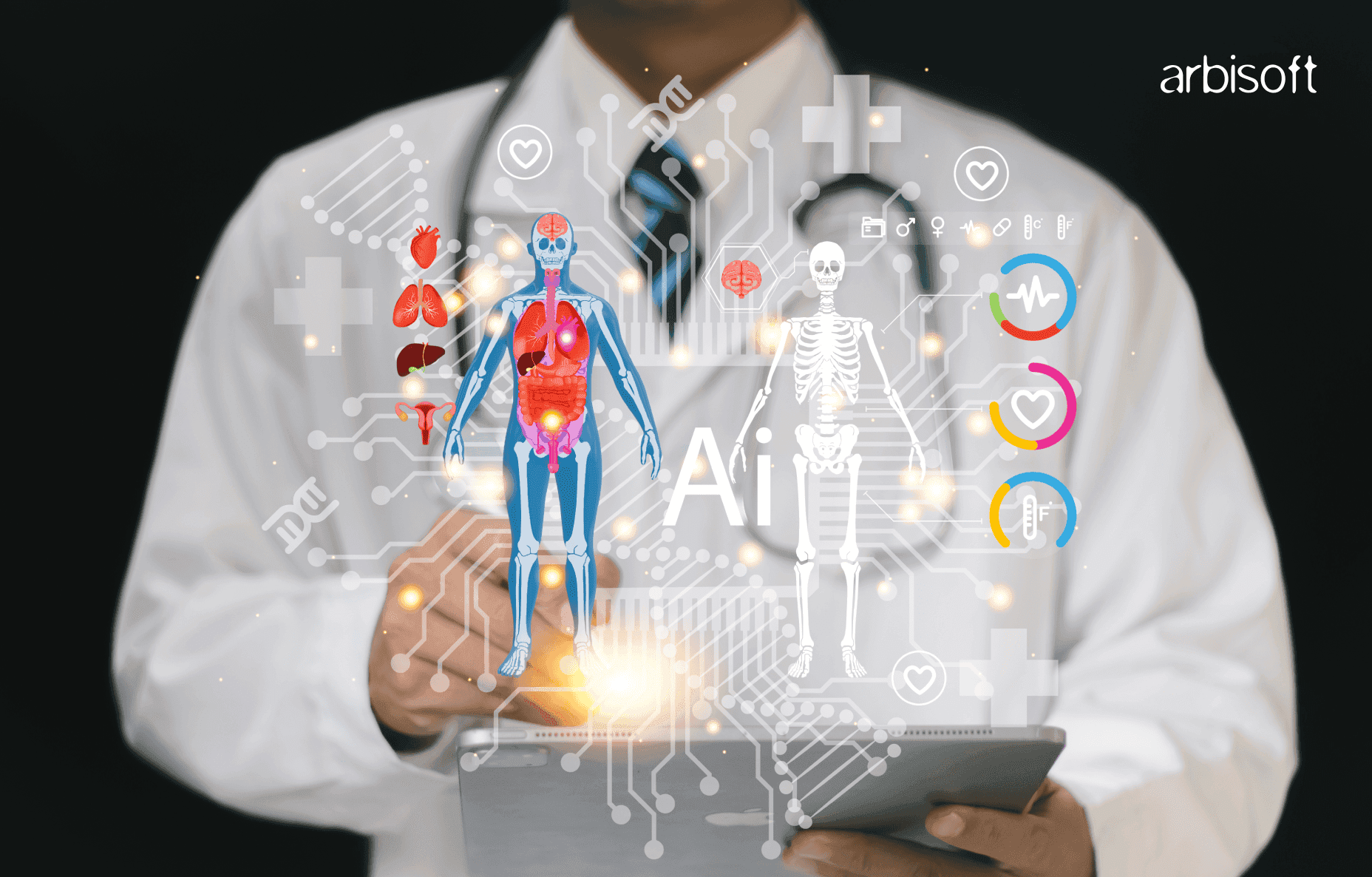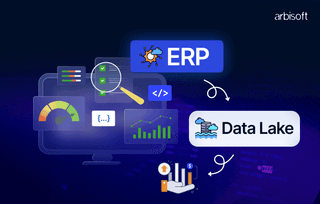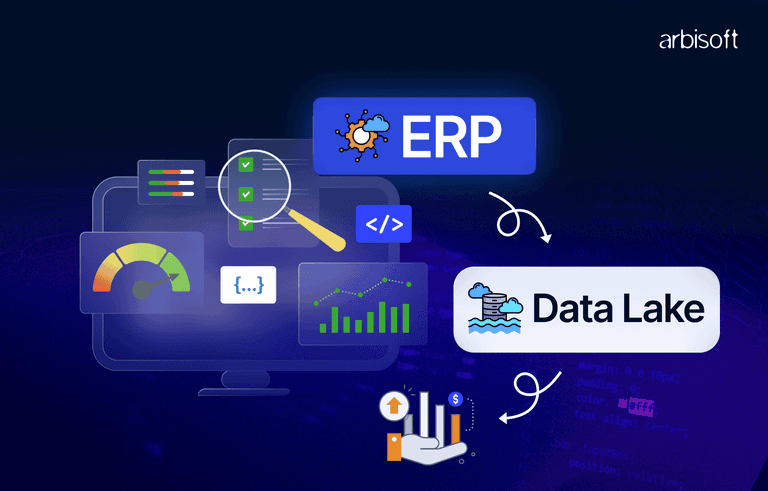We put excellence, value and quality above all - and it shows




A Technology Partnership That Goes Beyond Code

“Arbisoft has been my most trusted technology partner for now over 15 years. Arbisoft has very unique methods of recruiting and training, and the results demonstrate that. They have great teams, great positive attitudes and great communication.”
How To Apply Deep Learning For Medical Imaging And Diagnostics

A patient sits in the hospital, eyes fixed on the clock, heart racing with anticipation for their scan results. In a nearby room, a doctor scrolls through one image after another, searching for subtle signs that could provide a diagnosis. Both are waiting, both uncertain, and in these moments, every second counts.
This waiting and uncertainty come from the limits of traditional image reading, which is slow and dependent on human focus. Deep learning in medical imaging tackles this exact problem, offering faster, more consistent insights that help doctors act sooner and patients receive answers without delay.
But using deep learning in medical imaging is not simple. It is more than just adding new technology. Hospitals need good planning. They need the right data. They need careful testing. And they must make sure the system fits real medical practice. This blog will show the steps from idea to real impact. It explains how AI diagnostics in healthcare can truly make a difference in patient care.
Why Deep Learning Matters In Medical Imaging
Medical imaging is a key part of diagnosis. X-rays, CT scans, MRIs, and ultrasounds show what the eye alone cannot see. But reading these images needs skill, time, and full focus. With more patients every year and fewer specialists, the pressure on radiologists keeps rising.
Deep learning healthcare imaging can help with this. It learns directly from images. A model can be trained to notice small signs of disease, find problems, and measure changes over time. In the past two years, new methods like self-supervised learning and medical foundation models have moved the field forward. These models do not depend only on large labeled datasets. They can now also learn from big sets of unlabeled scans, which makes building them easier and faster.
The benefit becomes clear when we think about the patient waiting in the corridor. Faster results mean less waiting. Better detection means fewer mistakes. Doctors also get support to manage their heavy workload without losing quality. To make this happen, the first step is always to define the clinical problem clearly. This is where AI diagnostics healthcare begins to reshape the patient experience from uncertainty to clarity.
Recent Advances in Deep Learning for Medical Imaging
Deep learning is advancing medical imaging faster than ever. Deep learning healthcare imaging is transforming how radiologists work, enabling faster analysis and more accurate detection across multiple imaging modalities.
Researchers and hospitals around the world are using AI to detect diseases earlier, track changes more precisely, and reduce diagnostic delays. Here are some recent examples:
Early Detection of Alzheimer's Disease
Researchers at King George's Medical University (KGMU) in Lucknow, India, have integrated AI-enhanced MRI scans to detect early-stage Alzheimer's disease. By analyzing subtle changes in the hippocampus and neural connectivity, often before symptoms manifest, the AI system aids in early diagnosis, enabling timely interventions and personalized care strategies.
Predicting Dementia Risk from Brain Scans
A collaborative effort between the University of Edinburgh and the University of Dundee is analyzing over a million brain scans using AI to develop tools for predicting dementia risk. This initiative aims to identify patterns in CT and MRI scans, enhancing early diagnosis and treatment planning for dementia.
AI-Assisted Breast Cancer Detection
The UK's National Health Service (NHS) is conducting a large-scale trial using AI to detect breast cancer cases earlier and faster. The AI system compares mammogram scans against a database of thousands of images to identify anomalies, potentially doubling the capacity of radiologists and improving early detection rates.
These examples highlight the potential of deep learning, but implementing it in clinical practice requires careful, step-by-step planning.
Steps to Implement Deep Learning in Medical Imaging
Applying deep learning to medical imaging is a multi-stage process. Each step, from defining the clinical question to deploying models in hospitals, must be carefully planned and executed to ensure safe, reliable, and effective results. The following steps outline how healthcare teams can take a deep learning solution from concept to clinical impact.
Step 1: Define The Clinical Question And The Target Outcome
The first step is to clearly define the clinical problem. A deep learning system should never be built without a purpose. It must solve a need that improves patient care and helps doctors in their work.
Begin by setting specific goals. For example, you may want to detect bleeding in CT scans so treatment can start quickly. You may want to track tumor growth in MRI scans to guide therapy. Or you may want to screen retinal images to find patients at risk of vision loss. Each goal needs its own dataset, its own model, and its own way to measure success.
Defining outcomes is just as important. Outcomes should be measurable, such as higher accuracy, faster diagnosis, or fewer missed cases. You must also plan how doctors will use the system and what it should do when it is unsure.
Doctors should be involved from the start. Radiologists, oncologists, and other specialists can highlight the real problems they face in daily practice. Their input makes sure the system fits real clinical workflows. A clear problem and clear outcomes will guide all the work that comes after.
Step 2: Build A Robust Data And Labeling Strategy
Once the clinical problem is defined, the next step is collecting robust data. Deep learning fully depends on data. If the data is poor or biased, the model will follow suit.
The first rule is variety. Collect images from different hospitals, scanners, and patient groups. This helps the model learn broad patterns and perform well in real-world settings.
Next comes labeling. For simple tasks, labels can come from reports. For segmentation, pixel-level markings are needed. Experts usually provide these. To make labels more reliable, more than one expert can annotate, and their agreement should be checked. Clear and consistent rules for annotation are important.
There are ways to make labeling easier. Weak labels can be taken from radiology reports and checked by sampling. Tools like MONAI Label can speed up annotation. A baseline model can also create rough labels, and clinicians can correct them to save time.
Standardization matters too. DICOM files should be converted the same way. Images should be resampled carefully. Both raw and processed versions should be stored to track changes. Automated checks can catch errors or low-quality images.
Finally, strong governance protects both patients and data. Records must be anonymized. Clear rules for storage and access should be set. This keeps data safe, follows regulations, and builds trust.
Partners like Arbisoft provide deep learning solutions that help unlock the full potential of medical data, built on ethical, transparent, and privacy-conscious practices
Step 3: Select Modeling Approaches And Training Strategies
With the data ready, the next step is to choose suitable models and training strategies.
Segmentation often works well with U-Net and its variants. nnU-Net is widely seen as a strong choice because it automatically adjusts preprocessing and training steps to match the dataset. It has shown success across many medical imaging tasks.
For classification and detection, hybrid models that combine convolutional neural networks and transformers are effective. CNNs capture local image features while transformers capture broader context. Vision transformers, when pretrained and fine-tuned carefully, are now strong performers in medical imaging. These approaches are becoming the backbone of deep learning healthcare imaging, making diagnostic models both precise and scalable.
Volumetric data like MRI and CT often benefit from 3D models, which preserve the full spatial information across slices. These models require more computing power but deliver better accuracy.
When labeled data is scarce, self-supervised learning is very useful. Models can be pretrained on large amounts of unlabeled medical data and later fine-tuned on a smaller labeled dataset. These methods have repeatedly shown performance improvements.
Uncertainty handling is also important. Models should show not only predictions but also confidence levels. Model ensembles or Monte Carlo dropouts can estimate uncertainty. Calibration methods like temperature scaling make probability outputs more reliable.
Foundation models are emerging as well. Tools like MedSAM show how large pretrained models can be adapted for medical segmentation, though they still need careful validation before use.
Once models are chosen and training strategies planned, evaluation comes next.
Step 4: Build Rigorous Evaluation, Validation, And Clinical Testing
Evaluation proves whether a model is safe and effective in practice. It is not enough for a model to perform well on paper.
Metrics must reflect clinical needs. For detection tasks, sensitivity and false positives matter most. For rare conditions, precision-recall curves are more useful than accuracy. These metrics form the foundation of trustworthy deep learning healthcare imaging systems.
Strong validation pipelines are central to AI diagnostics in healthcare, where safety and reliability must match clinical expectations.
For segmentation, Dice scores and boundary metrics such as Hausdorff distance should both be reported. Calibration should also be measured to confirm that probabilities reflect real likelihoods.
Validation should go beyond internal tests. External validation on data from other hospitals is necessary to confirm that the model generalizes. Without this, the model may only work in narrow conditions.
Subgroup analysis is also essential. Performance can vary by patient age, sex, ethnicity, or scanner type. Reporting subgroup results ensures fairness and safety.
After retrospective validation, prospective studies are needed. Shadow deployment lets clinicians see predictions without acting on them, which gives feedback. Controlled trials can then test whether predictions improve care when they influence decisions.
Evaluation pipelines should be automated, with clear version control. Every result must be linked to the model and dataset that produced it. This ensures accountability and reproducibility.
Step 5: Use Privacy-Preserving Methods For Multi-Site Training
Strong models usually need diverse datasets, which often means collaboration between hospitals. This raises privacy concerns that must be addressed.
Federated learning allows hospitals to train models on their own data locally and share only updates. These updates are combined to build a global model, so raw patient data never leaves the hospital. Radiology projects have already shown that this approach works well.
Differential privacy can be added to further protect patients. It introduces controlled noise to updates so that individual records cannot be identified. This sometimes reduces accuracy slightly but strengthens compliance with laws and ethical standards.
Privacy measures must also be supported by governance. Agreements between hospitals, secure storage, strong access control, and regular audits are all essential. Building privacy protections into the system from the start ensures safety and trust.
Step 6: Prepare Regulatory Documentation And Plan For Lifecycle Management
Before deep learning systems can be used in clinics, they must pass regulatory approval.
In the United States, the FDA requires detailed submissions for AI medical devices. These include how the model was built, how it is validated, and how updates will be managed over time. Guidance has been issued for AI systems that evolve after deployment.
A full regulatory file should cover:
- Data sources and preprocessing steps.
- Model design and training details.
- Validation and evaluation results.
- Risk assessments and mitigation strategies.
- Instructions and training for clinicians.
- Backup steps for uncertain predictions.
Regulation also includes lifecycle management. Models must be monitored after deployment, retrained as new data becomes available, and updated carefully. This ensures ongoing safety and compliance.
Similar approaches are being applied in enterprise settings, where AI agents are redefining automation and decision-making.
Step 7: Build MLOps And Deployment Practices That Support Clinical Use
Even the best model can fail if not deployed with care. Operational practices make deployment reliable.
- Reproducibility is the first principle. Use containers, fixed dependencies, and version control so that every model can be rebuilt exactly. Each model version should be linked to its dataset and results.
- Deployment should fit into clinical workflows. For urgent cases such as stroke detection, models may need to run locally to avoid delay. For less urgent tasks, secure cloud deployment may be acceptable.
- Monitoring systems should track input data, prediction confidence, and performance trends. Alerts should trigger if data patterns shift or accuracy drops.
- Interfaces must be designed for doctors. Predictions should appear as overlays, scores, or notes that are easy to understand. Doctors should be able to adjust or reject predictions, and corrections should be saved for retraining.
- Fallback systems are critical. If the model is uncertain or performance drops, cases should go to human review or revert to a safer model version.
Such interfaces make deep learning for radiology a practical tool rather than a black-box system.
Step 8: Ensure Fairness, Explainability, Robustness, And Security
Trust depends on more than accuracy. A system must also be fair, explainable, robust, and secure.
Fairness requires audits. If the system works better for one group of patients than another, this gap must be found and corrected.
Explainability builds confidence in deep learning healthcare imaging. Heatmaps or saliency maps can show which parts of an image influenced the prediction. Clear explanations give doctors confidence in the system’s reasoning.
Robustness must be tested by simulating real challenges like noise or motion artifacts. A reliable system lowers confidence in these cases instead of producing false results.
Security is equally important. Models must be protected from manipulation with strong encryption, penetration testing, and anomaly logging.
Step 9: Run Phased Clinical Integration And Prospective Evaluation
Clinical integration should be gradual. This reduces risks and builds trust.
- Phase one is internal development and retrospective validation.
- Phase two is external validation on new hospital data.
- Phase three is shadow deployment where clinicians see predictions but do not act on them.
- Phase four is prospective trials where predictions guide decisions under supervision.
- Phase five is full deployment with monitoring.
At every stage, feedback from doctors is essential. Their insights, combined with performance data, guide adjustments and ensure safety. This iterative approach is what makes AI diagnostics healthcare both reliable and clinically effective.
Step 10: Maintain Continuous Improvement And Governance
The process does not end with deployment. Healthcare changes constantly, and models must evolve as well.
Regular retraining and revalidation with new data keep systems accurate. Feedback from doctors should guide updates, and improvements should be tracked in a clear backlog.
Transparency also matters. Publishing results, documenting errors, and issuing clear update notes support clinician trust.
Governance makes this continuous improvement safe. Oversight committees, monitoring pipelines, and accountability structures ensure that updates strengthen rather than weaken the system.
Practical Checklist For Teams To Apply Deep Learning For Medical Imaging And Diagnostics
- Define a clinical goal with measurable success criteria.
- Collect diverse, labeled datasets with strong governance.
- Apply self-supervised pretraining on unlabeled data.
- Benchmark with established baselines before testing new models.
- Run subgroup analysis to check fairness.
- Add uncertainty estimation for safer predictions.
- Use privacy-preserving methods for multi-site training.
- Prepare regulatory documentation early.
- Pilot in shadow mode before clinical use.
- Deploy with monitoring, reproducibility, and rollback options.
This checklist keeps teams focused and aligned as they move from concept to impact.
Just as deep learning enhances diagnosis, AI can also streamline the broader patient journey, supporting scheduling, triage, and follow-ups to ensure care is timely and continuous.
In Short,
Deep learning in medical imaging is a journey that begins with a patient waiting for answers and ends with tools that deliver those answers more quickly and reliably. Each step in the process, defining the clinical problem, preparing data, designing models, evaluating rigorously, ensuring privacy, meeting regulatory standards, deploying safely, and protecting fairness, builds toward the same goal.
That goal is not technology for its own sake, but better care. The clinician gains support in a demanding role, and the patient gains timely results with greater confidence. Deep learning, applied with responsibility and care, can transform medical imaging into a stronger ally for both.
FAQs
1. What is deep learning in medical imaging?
Deep learning is a type of artificial intelligence that learns patterns from medical images like X-rays, CT scans, MRIs, and ultrasounds. It can detect diseases, track changes, and help doctors make faster and more accurate diagnoses.
2. How does deep learning help doctors and patients?
It reduces the time needed to analyze images, lowers the chance of mistakes, and supports doctors in managing heavy workloads. Patients receive results faster and with higher confidence in the diagnosis.
3. What types of medical problems can deep learning address?
Deep learning can detect tumors, bleeding, fractures, or eye diseases. It can track changes in conditions over time and help screen patients at risk for certain diseases.
4. Why is good data important for deep learning?
Deep learning models learn from examples. If the data is poor, biased, or incomplete, the model’s predictions will be unreliable. Diverse and well-labeled datasets ensure better performance across different patient groups.
5. What is labeling, and why is it needed?
Labeling means marking images to show where a disease or feature appears. Accurate labeling helps the model learn what to look for. Multiple expert annotations and consistent rules make labels more reliable.
























